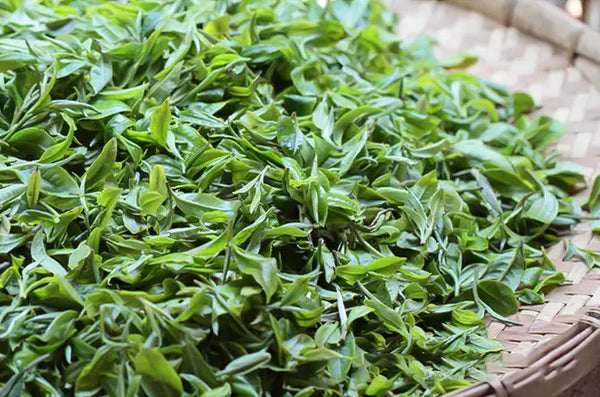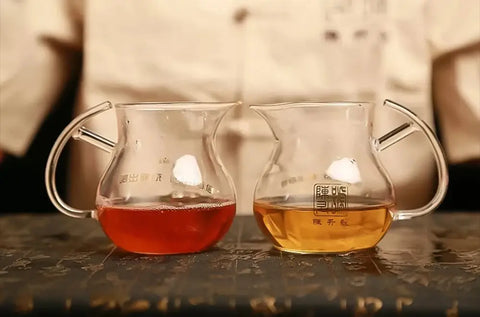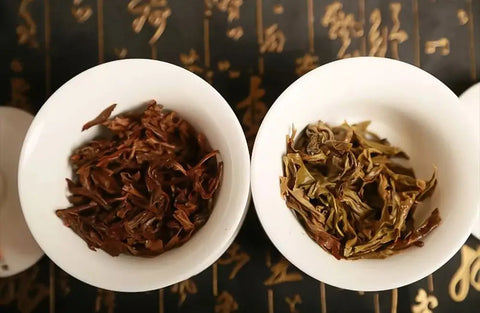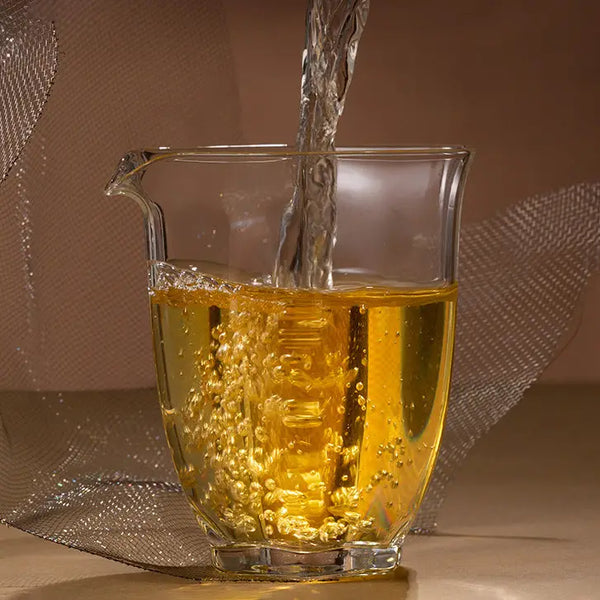Pu-Erh Tea 101: Everything You Need To About This Extraordinary Tea
Whether you drink tea religiously as a part of your daily activity or you just drink one occasionally for specific reasons, consuming tea is definitely something you have done in your life. This is expected especially since tea is one of the most famous and broadly consumed drinks in the world.
In recent years, however, a specific tea has been increasing in popularity and interest not only because of its outstanding taste but also because of its numerous health benefits - the Pu-Erh Tea. This tea is not new to ancient civilizations like China, but it is only now in the modern era that Pu-Erh tea is being appreciated and researched to unlock its fullest potential.
The past few years have certainly brought a fresh understanding to Pu-Erh tea, so to help ease and simplify the perplexity of Teas in general and to give you more reasons why you should start drinking Pu-Erh, this article will explain everything you need to know about Pu-Erh Tea.
Bestsellers
What is Pu-Erh Tea?
Pu-erh tea, made primarily in the Yunnan district in the southwestern province of China, is consumed sizable by the Chinese and other Asian people. The leaves and stems of the Camellia sinensis plant are responsible for producing Pu-erh tea. Other teas, including green, oolong, and black teas, are also made through the same plant. However, it must be noted that even if the same source plant is utilized, the different teas are produced employing other methods. After collecting the leaves and stems, the processing of Pu-Erh tea frequently comprises two stages. The tea leaves and stems are set comparable to green tea in the first stage. In the second stage, under extreme humidity, the plant’s components are arranged to undergo fermentation and then sustained storage, or a process known as aging. With that, Pu-erh tea is made through fermentation just like black tea; however, the fermentation time of Pu-Erh tea is longer than the usual black tea. Furthermore, the microorganism Aspergillus niger is also frequently observed in matured Pu-Erh tea. Therefore, pu-erh tea that is developed for an extended period is assumed to taste better. These features of Pu-erh tea contrast significantly from those other teas, which usually do not undergo fermentation and should be consumed as fresh as possible not to fluctuate its taste.
History of Pu-Erh Tea
About 4700 years ago, many people in Ancient China strongly believed that drinking Pu-Erh tea could help in treating various illnesses, including flu, constipation, diarrhoea, body pains, and other diseases. Anthropologists and historians linked the origin of this belief to the cultural groups situated in Southwest China – Dai and the Aini ethnic groups.
In the Dai and Aini Ethnic groups, the tea tree plant known as Camellia sinensis has unique characteristics, including large leaves. Also, unlike other teas, the tea produced from the large leaves of Camellia sinensis does not lose its flavour over time due to its intrinsic qualities. With that, the taste of Pu-Erh tea becomes better as time goes by. This certain quality of Pu-Erh has made the royals of ancient China keep this secret for many people outside of the country.
According to historical reports, during the Tang Dynasty, merchants started to pack the large leaves of Camellia sinesis and compressed them into blocks to trade northwards through Yunnan province and then up to the mountains of Tibet. These tea blocks made it easier for merchants to move packs compared to those other loose-leaf teas at that time.
The people of Tibet were avid drinkers of tea; yet, the environmental condition of the region did not make it possible to grow trees and produce tea. Tibet was located high up on the mountains, about 13,200 feet in Lhasa. However, Tibetans could yield resilient and swift mountain horses that China needed for its growing army. The supply of these horses is the main reason why China traded tea blocks to the mountains of Tibet. In addition to that, these tea blocks were also changed and sold to lands outside the country.
Merchants, at that period, observed that months-long transport towards the mountains or to other countries produced changes in the appearance and the taste of the tea, making it richer in flavour. In addition, during transport, the tea frequently became wet and absorbed a large amount of humidity, which stimulated microorganisms to start slow bacterial fermentation. At that time, merchants realized that ageing and fermentation produced beneficial biological changes in the tea.
Due to this newly discovered taste and processing for Pu-Erh teas, the beverage became significantly sought-after by people across the land. The popularity even further increased due to its believed medicinal properties. Many then began to recognize that the best Pu-erh teas underwent ageing and fermentation for more than ten years.
So, as the years went by, the consumption of Pu-erh teas was higher than its supply. Hence, demand significantly increased. So in the 1950s, tea makers from Yunnan, China developed a way to hasten the process of fermentation and produce more tea available faster. Wet piling the tea was applied. This method produced the tea known today as Shu or Shou Pu-Erh, which means cooked or ripe Pu-erh. This tea is dissimilar to what merchants have transported in Tibet, which was traditionally compressed and aged and referred to as Sheng or raw Pu-Erh.
How Is It Made?
Pu-Erh tea is produced from the large-leaf species of Camellia sinensis. Today, the modern production of Pu-Erh tea is complex, yet it still follows the traditional way of producing the tea.
Using one bud and two to three leaves of Camellia sinensis, processing of Pu-erh tea is usually made through two steps. First, all leaves must be generally treated into Maocha in order to halt oxidation. Second, Maocha should then be prepared to undergo fermentation or it can also be straightforwardly packaged and sold.
-
Production of Maocha
The purpose of producing Maocha or rough tea is to desiccate the leaves and to eliminate the risk of spoiling. Therefore, little processing is done in this first stage of Pu-erh tea production, and almost no fermentation occurs.
The first step in making raw or ripe Pu-erh tea is to pick the ideal and healthy leaves of Camellia sinensis. Harvested leaves are handled delicately to avoid damaging the leaves and causing possible unnecessary oxidation. Wilting and withering after harvesting the leaves can also be done, depending on the method utilized by the tea makers. Once harvested, drying happens at different stages of processing to produce Maocha.
Lao Ban Zhang

(Tea farmers are plucking fresh tea leaves for Chen Sheng Hao)
- Harvested leaves are also dry roasted in a large pan to stop enzymatic activities and avoid complete oxidation. After this, dried leaves are rolled, rubbed, formed into strands, and then dried again under the sun. This dry roasting step of Pu-erh tea is dissimilar to green tea produced in China, dried using hot air. Dry roasting in wok or pan leaves a minute number of enzymes which allows minimal oxidation to the leaves during the sun-drying process. Bruising of the tea is also done before sun-drying to minimize oxidation and add a unique flavor to Pu-erh tea.


-
Once Maocha is produced, it can then be processed to yield ripened or fermented Pu-erh or pressed into several shapes as sold as raw Sheng Cha or raw Puerh. Maocha can also be marketed directly or in the loose-leaf form.
-
Pressing the tea
Before the definite pressing of the tea, there are a lot of extra steps that are required to be done. First, a substantial number of dry Maocha or ripened tea leaves are weighed. Once done with weighing, dry tea is then carefully steamed in holed containers to unstiff and make the dry tea tackier. Softening the dry tea permits it to be held together and not collapse during pressing.
Additional embellishments such as inner tickets are placed on or in the middle of the dry tea and upended or enveloped in cloth. The tea is then assembled inside the material and compressed into a globe or ball, with some spare cloth tied around itself. A cleft groove or indentation at the reverse side of the tea block is then created after pressing because of the coil or knot.
After pressing the dry tea, Pu-erh tea is detached from the cloth bag and positioned on shelves or countertops, where the tea is permitted to air dry, which usually takes numerous weeks or months to completely dry. This drying process greatly varies depending on the moisture of the pressed tea. Once completely dried out, each Pu-Erh is packed by hand individually.
-
Tea Fermentation Stage
Microorganisms living on the harvested leaves of Camellia sinensis act on a series of enzymatic reactions that lead to the fermentation of the tea. So with that, unlike all other teas, such as black teas that were only oxidized through inherently present tea enzymes, Pu-erh tea is considered a fermented tea due to microbial processing.
Pu-erh tea particularly undergoes a solid-state fermentation process. There is little to no water activity in the tea at this stage. In addition, Endo-oxidation and Exo-oxidation of tea polyphenols also happen in this stage. Studies show that several different organisms are responsible for the post-fermentation of Pu-erh tea. These microorganisms include Aspergillus niger, Aspergillus glaucus, Penicillium, Saccharomyces, and others. In this wide array of microbes, studies have observed that the Aspergillus species is the principal species.
It usually takes several weeks for fermentation to take place. In modern methods of producing Pu-erh tea, dominant microorganisms such as Aspergillus are additionally inoculated to hasten the process of fermentation. Studies have shown that introducing dominant species in solid-state formation could yield similar Pu-erh tea characteristics to that Pu-erh tea that aged naturally for a while through spontaneous fermentation. However, modern Pu-erh tea making gives high importance to the specific type of microorganism utilized for post-fermentation because certain microbes affect the biochemical composition of the final Pu-erh tea product. Today, manufacturers use these biochemical changes to improve and deliver better tea taste and aroma and several health benefits.
Active Components
Pu-erh tea, produced naturally from the leaves of Camellia sinensis, has different active components that give its specific aroma, taste, color, and health benefits. Slight differences in the levels of the active ingredients in fresh Camellia sinensis leaves and Pu-erh occur due to the series of steps in the production of Pu-erh. However, studies show that the biochemical components found in leaves of Camellia sinensis are comparable to those found in raw,processed, and fermented Pu-erh.
Several studies have been conducted to determine the active component of Pu-erh. As a result, several active compounds have been identified and isolated today, such as flavonoids and hydrolyzable tannins. These active components are measured to be the main components responsible for the significant antioxidative properties of Pu-erh. Furthermore, according to the various chemical configurations, these dynamic factors of Pu-erh tea can be further classified into four subcategories:
- Flavones and their derivatives and byproducts – These active components such as quercetin, kaempferol, myricetin.
- Flavonols and their derivatives and byproducts include catechins, which are considered the major chemical component of Pu-erh, and regular green teas.
- Alkaloids and their derivatives and by-products – Caffeine, Theophylline, and Theobromine are part of these compounds. Studies show that the amount of caffeine in raw Pu-erh tea is highest among all measured alkaloids. Raw Pu-erh has the highest caffeine content. Furthermore, compared to regular green tea, raw Pu-erh tea also has higher theobromine and theophylline content.
-
Phenolic compounds. Simple phenolic acids such as gallic acid, coumaric acid, and caffeic acid are included in this subgroup. Other compounds such as quininic acid derivatives and hydrolyzable tannins are also part of this subgroup.

Pu-erh Tea: Ripe vs Raw
Pu-erh tea can be classified as Ripe Pu-erh tea known as Shu Cha or Shu Pu-erh and Raw Pu-erh or Sheng Cha. Both of these types of Pu-erh can vary in shape, aroma, flavor, and appearance. So, to understand how they differ, below is a table comparing each type of Pu-erh:
-
Ripe Pu-Erh Tea
-
Definition
a Pu-erh tea that is made from large leaves of Camellia sinensis and undergoes a wet piling process to stimulate fermentation.
-
Process Production
The process of producing Ripe Pu-erh tea begins just like that of the Raw Pu-erh tea. It starts with harvesting the large leaves of Camellia sinensis, withering, pan-frying, sun drying, and aging. However, unlike Raw Pu-erh tea, Ripe Pu-erh tea undergoes the wet piling process which is responsible for the fermentation or accelerated aging process of Pu-erh. Below are the general steps of wet piling:
- The processed tea leaves are arranged to a specific height that is frequently about 70 to 80 cm.
- Once the leaves are piled up, water is then added to wet the tea leaves. This is followed by the covering of linen cloth. These steps permit for the tea leaves to be in a humid environment so it can accommodate fermentation to occur.
- Aspergillus niger, the principal fungus responsible for fermentation, is then inoculated to the tea leaves to supplement the fermentation process.
- Once the specific fermentation level has been reached, the tea is then un-piled and aired out.
- Most tea makers only age Ripe Pu-erh for about 10 years because it generally has reached its optimum taste.
-
Aging Potential
Generally, Ripe Pu-erh tea has an aging potential of approximately 20 years. During this time, the flavor development has already plateaued. Hence, aging is not suggested more than this length.
-
Taste, Flavor, and Aroma
Due to the fermentation process and stimulation of tea catechins brought about by the wet piling method, Ripe Pu-erh tea has a precise and unique mild flavor. Most of the time Ripe Pu-erh tea has a basic leafy rich smell. Ripe Pu-erh tea is smooth and mellow which is ideal for day-to-day regular drinking. Because it underwent an accelerated aging process, Ripe Pu-erh tea has a richer and smoother amora compared to Raw Pu-erh tea.
-
Color of Drink
Ripe Pu-erh tea possesses a Dark red tea color. This is brought about by the accelerated aging process.
-
Price
Ripe Pu-erh is commonly cheaper compared to Raw Pu-erh because it requires less time to produce. The environmental factors for aging to occur are also not as complex as Raw Pu-erh.
-
Definition
-
Raw Pu-erh Tea
-
Definition
a Pu-erh that is produced from large leaves of Camellia sinensis and processed like that of green tea. This means Pu-erh simply underwent roasting to halt the oxidation and did not undergo the piling process.
-
Process Production
The process of producing Raw Pu-erh tea is almost similar to Ripe Pu-erh tea. When large leaves of Camellia sinensis are harvested, it is swiftly roasted in order to halt the oxidation process in the leaves. This step is also similar to green tea production. After roasting, the tea leaves are dried under the sun and steamed in order to be compressed. It is usually compressed into cakes or round disks. Once compressed it is then stored for the cakes to be allowed to age until the tea leaves’ desired taste is ultimately achieved.
It must also be noted that the key difference in the process of producing Raw Pu-erh tea is the lack of the wet piling process that is done for Ripe Pu-erh.
-
Aging Potential
The goal of Raw Pu-erh is for it to age for a longer period of time to achieve a fuller flavor. With that, Raw Pu-erh tea usually has an aging potential of about 60 to 70 years, depending on the goal of the tea maker.


(Right: 2009 Emperor Raw Puerh, left: 2018 Emperor Raw Puerh from Chen Sheng Hao ) -
Taste, Flavor, and Aroma
Generally, Raw Pu-erh Tea has a broader range of flavors compared to Ripe Pu-erh. For a younger Raw Pu-erh tea, it usually has bittersweet, floral, and grassy features. However, as the natural microbial process occurs over time, the taste, flavor, and aroma of Raw Pu-erh considerably transform. Older Raw Pu-erh tea ordinarily loses the bitterness of the younger type of Raw Pu-erh. This type of tea also has a particular Chestnut aroma. Also, because Raw Pu-erh tea does not undergo the wet piling method, it normally maintains a fresh scent as well as a modest flavor of astringency, with a particular sweet aftertaste.
-
Color of Drink
Raw Pu-erh tea usually has a bright yellow tea color.
-
Price
Due to the longer time required to produce Raw Pu-erh tea, the tea is usually priced more expensive compared to Ripe Pu-erh tea. Maintaining ideal environmental conditions to allow the natural microbial aging process in Raw Pu-erh also is a contributory factor to its more costly price.
-
Definition
Benefits of Drinking Pu-Erh Tea
Now that you have been introduced to Pu-erh tea, how it is produced, and what are its different types, it is time to know what are the advantages of drinking Pu-erh tea.
For years, Pu-erh tea has been highly sought-after all over the world not only for its particular satisfying taste but also for its perceived medical benefits.
-
Aids in weight loss
Pu-erh tea can aid in weight loss by promoting the hydrolysis of stored body fat while reducing the synthesis of new fat, as supported by the studies conducted by researchers such as Zou et al. in 2012 and Jensen et al. in 2016 animal studies.
In addition to that, studies conducted by Huang in 2019 and Ye et al. in 2021 have shown that Pu-erh tea can provide beneficial gut microbiota that can result in reducing body weight gain and fat accumulation in obese induced animal subjects.
Lastly, a study conducted by Kubota et al. in 2011in Japanese adults with Preobese and overweight Body Mass Indices has shown that drinking Pu-erh tea 3 times daily can aid in reducing body weight which then resulted in a decreased body mass index and abdominal fat measurements.
However, it must be noted that the impact of Pu-erh tea on weight loss is still controversial due to the fact that most studies were conducted in animal subjects and not in human samples. Hence, more research is still warranted to directly correlate the weight loss benefit to Pu-erh tea consumption.
-
Improve liver health
Some research on Pu-erh tea has observed that it may aid in preventing or reversing liver disease such as nonalcoholic fatty liver disease. This has been shown in an animal study conducted by Cai et al. in 2016 Pu-erh tea extracts hindered high fat diet-induced obesity and high fat induced-liver fat accumulation and liver injury and damage in animal subjects. Another study by Zheng et al. in 2014 also observed that administration of Pu-erh extracts can help protect the liver from damaging side effects of drugs such as cisplatin which is a chemotherapeutic drug with a well-known liver injury complication.
-
Better skin health
Consumption of Pu-erh tea extract may help promote better skin health and prevent skin oxidative damage from harmful environmental conditions and pollution. This is supported by the study conducted by Roda et al. in 2019 wherein Pu-erh extracts have been observed to have high antioxidant ability due to its high polyphenol content. Furthermore, the same researchers have noted that there is an association between antioxidant levels of Pu-erh and its inherent enzyme inhibition activity that can be utilized in the application of skin care and anti-aging products in the future.
In addition to this, as noted by Bonte et al. in 2016, Pu-erh extract has the capacity to fight skin aging due to its detoxifying and elastin-protecting ability. Elastin has been known to be one of the major proteins in the skin being modified as one becomes older. Pu-erh extract, having a higher concentration of polyphenols, specific catechin, and catechin oligomers, can aid in protecting the skin by preventing protein modification of elastin.
-
Correcting cholesterol levels
A study conducted by Hou et al. in 2009 has shown a reduction in “bad cholesterol” levels known as Low-Density Lipoprotein in animal subjects administered Pu-erh tea extract. Furthermore, Huang et al. in 2019 were also able to observe that Theabrownin, one of the most abundant pigments and metabolically active components in Pu-erh tea, has elevated the levels of ileal conjugated bile acids. This increase resulted in stimulation of the intestinal signaling pathway, which resulted in decreased hepatic cholesterol.
However, just like for Pu-erh tea weight loss research, most studies on the impact of drinking Pu-erh tea on cholesterol levels were conducted in animal subjects. Hence, more research should be done to correlate cholesterol levels with the consumption of Pu-erh tea.
Safety and Precautions
Research shows that Pu-erh tea has very high caffeine content. In fact, a cup of Pu-erh extract can contain about 50 to 100 mg of caffeine. With that, the increased concentration of caffeine is responsible for most of the side effects of Pu-erh consumption.
According to the Food and Drug Administration, healthy adults can tolerate drinking caffeine of about 400 mg daily, which is about four to five cups of coffee. So, drinking Pu-erh tea that exceeds that amount of caffeine content can cause side effects which include palpitations, difficulty sleeping, dizziness, dehydration, diarrhea, and excessive urination. Research also shows that excessive caffeine consumption may impact digestion and cause an upset stomach.
Three cups of Pu-erh tea are deemed to be safe. Hence, research suggests that this should be the maximum daily intake of Pu-erh tea, depending on another caffeine intake of a consumer.

(Source: cspuerh.com)
How to Prepare a Pu-Erh Tea?
Now that you are knowledgeable about Pu-erh tea, you are ready to consume this extraordinary beverage. Although Pu-erh can be intimidating at first, preparing it is really not that hard. Here are the steps you can follow:
- If you are making Pu-erh from a tea cake, gently break about a teaspoon of Pu-erh tea and if you are making Pu-erh from loose-leaf teas, get two to three leaves;
- Place the Pu-erh tea in a teapot and add an ample amount of boiling water to cover the leaves;
- Remove the water from the pot. Repeat steps 2 and 3 once again. This step of rinsing your Pu-erh is highly necessary to remove dust accumulated during the fermentation process and to “activate” the leaves for the infusion stage;
- Once done with the rinsing step, pour boiling water (about 205 F) and permit the tea to steep for about a minute or two;
- After steeping, pour the tea into cups and enjoy your Pu-erh tea experience.
Bottom line:
Pu-erh Tea, a fermented tea that originated from the Yunnan district in the southwestern province of China, has been increasing in popularity over the past few years. This exceptional beverage continues to be highly regarded even after being discovered thousand years ago due to its unique method of production and matchless taste, flavor, and aroma.
No matter what you prefer, whether it be Raw or Ripe Pu-erh tea, you can be assured that the Pu-erh tea does not only deliver a delightful gustatory experience but also provides a wide array of health benefits from weight loss to better skin health.
So, if you are thinking of starting to drink Pu-erh tea, for whatever reason that may be, this is definitely the sign you are looking for.
References:
- Bonte, F., Ulrichova, J. and Saladin, R. 2016. 157 - Skin Antiaging and Detoxifying Properties of Ancient Tea Forest Pu’er Tea. Free Radical Biology and Medicine. 100. https://doi.org/10.1016/j.freeradbiomed.2016.10.198
- Cai X, Fang C, Hayashi S, Hao S, Zhao M, Tsutsui H, Nishiguchi S, Sheng J. Pu-erh tea extract ameliorates high-fat diet-induced nonalcoholic steatohepatitis and insulin resistance by modulating hepatic IL-6/STAT3 signaling in mice. J Gastroenterol. 2016 Aug;51(8):819-29. doi: 10.1007/s00535-015-1154-0. Epub 2016 Jan 21. PMID: 26794005.
- Duh, Pin-Der; Yen, Gow-Chin; Yen, Wen-Jye; Wang, Bor-Sen; Chang, Lee-Wen (2004). Effects of Pu-erh Tea on Oxidative Damage and Nitric Oxide Scavenging. Journal of Agricultural and Food Chemistry, 52(26), 8169–8176. doi:10.1021/jf0490551
- Hou Y, Shao W, Xiao R, Xu K, Ma Z, Johnstone BH, Du Y. Pu-erh tea aqueous extracts lower atherosclerotic risk factors in a rat hyperlipidemia model. Exp Gerontol. 2009 Jun-Jul;44(6-7):434-9. doi: 10.1016/j.exger.2009.03.007. Epub 2009 Apr 5. PMID: 19348878.
- Huang, F., Zheng, X., Ma, X. et al. Theabrownin from Pu-erh tea attenuates hypercholesterolemia via modulation of gut microbiota and bile acid metabolism. Nat Commun 10, 4971 (2019). https://doi.org/10.1038/s41467-019-12896-x
- Jensen GS, Beaman JL, He Y, Guo Z, Sun H. Reduction of body fat and improved lipid profile associated with daily consumption of a Puer tea extract in a hyperlipidemic population: a randomized placebo-controlled trial. Clin Interv Aging. 2016;11:367-376. Published 2016 Mar 24. doi:10.2147/CIA.S94881
- Jensen GS, Beaman JL, He Y, Guo Z, Sun H. Reduction of body fat and improved lipid profile associated with daily consumption of a Puer tea extract in a hyperlipidemic population: a randomized placebo-controlled trial. Clin Interv Aging. 2016;11:367-376. Published 2016 Mar 24. doi:10.2147/CIA.S94881
- Kubota K, Sumi S, Tojo H, Sumi-Inoue Y, I-Chin H, Oi Y, Fujita H, Urata H. Improvements of mean body mass index and body weight in preobese and overweight Japanese adults with black Chinese tea (Pu-Erh) water extract. Nutr Res. 2011 Jun;31(6):421-8. doi: 10.1016/j.nutres.2011.05.004. Epub 2011 Jun 17. Erratum in: Nutr Res. 2012 Jun;32(6):470. PMID: 21745623.
- Lee, L.K.; Foo, K.Y. (2013). Recent advances on the beneficial use and health implications of Pu-Erh tea. Food Research International, 53(2), 619–628.doi:10.1016/j.foodres.2013.02.036
- Lv, Hai-peng; Zhang, Ying-jun; Lin, Zhi; Liang, Yue-rong (2013). Processing and chemical constituents of Pu-erh tea: A review. Food Research International, 53(2), 608–618.doi:10.1016/j.foodres.2013.02.043
- Roda G, Marinello C, Grassi A, et al. Ripe and Raw Pu-Erh Tea: LC-MS Profiling, Antioxidant Capacity and Enzyme Inhibition Activities of Aqueous and Hydro-Alcoholic Extracts. Molecules. 2019;24(3):473. Published 2019 Jan 29. doi:10.3390/molecules24030473
- U.S. Food and Drug Administration. 2018. Spilling the Beans: How Much Caffeine is Too Much?. Retrieved from: https://www.fda.gov/consumers/consumer-updates/spilling-beans-how-much-caffeine-too-much. Retrieved on 15 February 2022.
- Ye J, Zhao Y, Chen X, Zhou H, Yang Y, Zhang X, Huang Y, Zhang N, Lui EMK, Xiao M. Pu-erh tea ameliorates obesity and modulates gut microbiota in high fat diet fed mice. Food Res Int. 2021 Jun;144:110360. doi: 10.1016/j.foodres.2021.110360. Epub 2021 Apr 5. PMID: 34053553.
- Zhang Y, Skaar I, Sulyok M, Liu X, Rao M, Taylor JW. The Microbiome and Metabolites in Fermented Pu-erh Tea as Revealed by High-Throughput Sequencing and Quantitative Multiplex Metabolite Analysis. PLoS One. 2016;11(6):e0157847. Published 2016 Jun 23. doi:10.1371/journal.pone.0157847
- Zheng XN, Wang XW, Li LY, Xu ZW, Huang HY, Zhao JS, Zhang D, Yin X, Sheng J, Tang JT. Pu-erh tea powder preventive effects on cisplatin-induced liver oxidative damage in Wistar rats. Asian Pac J Cancer Prev. 2014;15(17):7389-94. doi: 10.7314/apjcp.2014.15.17.7389. PMID: 25227847.
- Zou XJ, Ding YH, Liang B. [The mechanisms of weight-cutting effect and bioactive components in Pu-erh tea]. Dongwuxue Yanjiu. 2012 Aug;33(4):421-6. Chinese. doi: 10.3724/SP.J.1141.2012.04421. PMID: 22855451.
← Older post Newer post →











